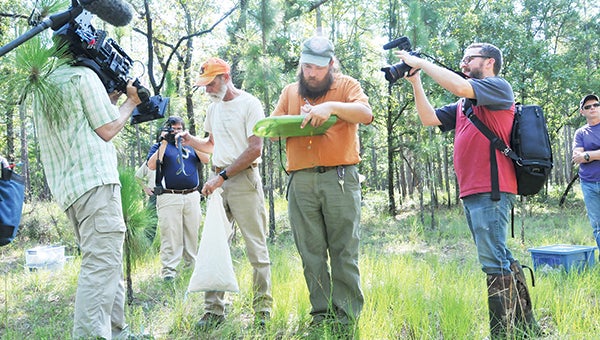RELEASE INTO WILD
Published 12:05 am Saturday, July 25, 2015

Above: Local Herpetologist Jimmy Stiles records what snake is being released as a TV crew and Auburn University students document the release in the Conecuh National Forest. | Andrew Garner/Star-News
9 more indigo snakes released into Conecuh
Nine Eastern indigo snakes were released in the Conecuh National Forest for the first time since 2013 on Friday morning.
“It was fantastic to be able to release them,” Local Herpetologist Jimmy Stiles said. “We really need to keep putting snakes out there every year to keep that population going.”
Stiles, along with other zoologists, biologists, zoo curators and forest rangers were present for the releasing of the threatened species. The slow growth of population by humans in the area, as well as timber harvesting, a decrease of fire as a forest management tool, and a decline of gopher tortoise populations are credited with the snake’s demise. Before the re-population project, which began in 2010, the last known sighting of the snake in the wild locally was in 1954, just north of Florala. In 1978, the snake was placed on the endangered species list.
The Orianne Center for Indigo Conservation at the Central Florida Zoo brought six snakes, and Zoo Atlanta brought three for the release.
“Let’s go release some snakes,” Stiles said once each snake was measured, weighed and checked for passive integrated transponder, or PIT tags. The tags help scientists monitor the snake’s growth while out in the wild.
Stiles said the nine released yesterday bring the total to 107 that have been released in the Conecuh National Forest, adding that the releasing event takes place once a year. Including this year, indigo snakes have been released in the forest, which provides the best habitat for the snake, in 2010, 2011, 2012 and 2013.
“Once a year — that’s what we aim to do, but we want to release ideally between 30-40 snakes a year,” he said.
Stiles said he hasn’t seen any offspring from the snakes, but has seen plenty of tagged snakes.
“We go back in the winter when it’s a little bit easier and do surveys for them,” he said.
The Eastern indigo snake is the largest North American snake, with adult lengths exceeding 8 feet. Indigo snakes are a glossy, bluish-black color, which is where one portion of their name originates. Indigo snakes are harmless. Their food source includes small animals, birds, toads and frogs, lizards, snakes (venomous and non venomous) and other indigo snakes, to name a few.
Releasing the nine indigo snakes was a collaborative effort between the U.S. Forest Service, the Alabama Department of Conservation and Natural Resources, the Orianne Center, Zoo Atlanta, the Natural Resources Conservation Service, the U.S. Fish and Wildlife Service and Auburn University.
Not far from the Solon Dixon Forestry Center, the snakes — one by one — were released into their new homes — gopher tortoise holes. The gopher tortoise and its burrow provide protection from predators and extreme environmental conditions.
Carl Petrick, forest supervisor with the USDA, said the Conecuh National Forest is the perfect place for the indigo snake.
“You really don’t know how special this area is, and how rare this type of ecosystem is,” Petrick said.
In fact, the Conecuh National Forest is the largest contiguous track of longleaf in the world, Stiles said.
Once released, it takes the snakes a few days to figure out their surroundings and to get used to their new environments.
Auburn University Zoologist Jim Godwin released one of the snakes and said it took a while for it to accept its new home.
“That was a good release,” Godwin said. “You can tell that the eyes are opaque and it will shed in a few days. When we put him down there, he was testing the environment.”
Also present for the release was a TV camera crew with Georgia Public Broadcasting, who was filming for a one-hour documentary on the longleaf pine.
Stiles said the time and effort put in the project so far has paid off.
“It’d be a shame for people to lose interest and things go downhill,” he said. “We’re able to keep pretty good momentum.
“Being able to release snakes was a huge thing for (Friday),” he said.




